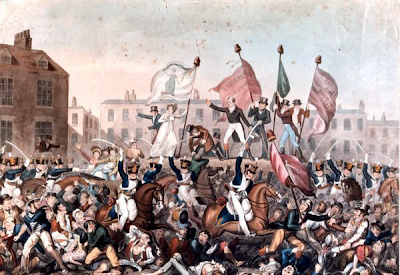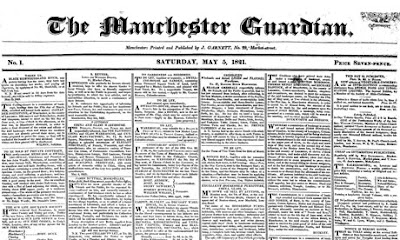 |
| By Richard Carlile, 1819 |
Today we pay tribute to a dark anniversary in the Regency calendar; a world away from princesses, empires and poets, on 16th August, we remember the anniversary of the 1819 Peterloo Massacre.
It was a time of great social imbalance; a tiny minority of the population was eligible to vote, jobs were hard to find and people were starving as the Corn Laws of 1815 saw bread prices soar. Protests were rife among the increasingly politicised working classes and the strength of public feeling caused people take to the streets in a series of protests and demonstrations, one of which was scheduled for St Peter's Field, Manchester, on 16th August 1819.
The Manchester Patriotic Union Society organised a rally to be held at which the key speaker would be the famed orator and politician, Henry Hunt, a sure crowd-pleaser. As the summer morning drew on people from across the north of England assembled at St Peter's Field until the audience numbered over 60,000, much to the horror of watching officials. In fact, those attending did so in a highly organised manner, intent on sending a peaceful yet strong message to the government, a plea for suffrage reform. The occasion was particularly notable for the number of women in attendance, represented by members of the northern Female Reform Societies; there were women on the platform itself and they numbered among the casualties of the day.
 |
| Henry Hunt by Adam Buck, 1810 |
Thrown into a panic at the size of the peaceful crowd, local magistrate William Hulton gave the order to arrest the speakers. However, the crowd around the hustings were packed in tight and Hulton issued further orders, this time for armed intervention.
Hundreds of soldiers surrounded the rally both on foot and horseback as the Yeomanry, under the command of Captain Hugh Birley and Major Thomas Trafford, moved in to make the arrests. Eye witnesses at the time claimed that many of the yeomen were drunk and that they were using the opportunity to settle personal scores and vendettas; some among their number tried to calm the situation but the majority were already set for a fight. The crowd linked arms and held back the advancing Yeomanry who led the charge that began the massacre; interpreting the resistance as an act of aggression, Lieutenant Colonel Guy L'Estrange led the sabre-wielding Hussars into the crowd and the massacre began.
It was all over in a matter of minutes and by two o'clock St Peter's Field had become a scene of horror as members of the peaceful crowd lay dead beneath the banners of suffrage, blood staining the red caps of liberty. Journalists were arrested and those who reported on the tragedy were imprisoned. As speakers, protesters and organisers were tried for High Treason, the magistrates who had ordered the assault and the Hussars who had carried it out were lauded by the Prince Regent as heroes. The strength of public feeling was so great that a test case against some of the military leaders was brought at Lancaster Assizes three years later, but all were cleared.
 |
| First edition of The Manchester Guardian |
Around 15 people died that day and hundreds more suffered terrible injuries, some dying after the event. Nicknamed Peterloo in ironic response to the courageous acts of soldiers at Waterloo, the atrocity led to rioting in the streets of Manchester and other northern cities. Fearing further unrest the government clamped down hard on reformers and crushed any suggestion of further demonstration or uprising.
The Massacre had a far reaching impact; Shelley wrote The Masque of Anarchy in response to Peterloo and John Edwards Taylor went on to found The Manchester Guardian as his own reply to attempts to stifle the free press; that newspaper still exists today. The Peterloo Massacre is commemorated to this day and remains one of the blackest days in the history of Georgian England.
| Memorial plaque on the former site of the Free Trade Hall |
12 comments:
Wow! Exciting and revolutionary times. Trying the speakers/organizers for treason: I thought this kind of thing only happened in pre-independence Dublin...
We Georgians sadly don't tend to drag our heels when it comes to stamping on reformers!
Loved this posting... and I learn't something new this day. Thanks.
Another great post. Thanks.
A pleasure!
This is certainly a day that lives in infamy. The British aristocracy were terrified that any kind of assembly of "radicals" could spark a debacle similar to the French Revolution. Hence the brutal repression of any show of egalitarianism.
Excellent post and a reminder (when we wag our fingers at countries across the globe than now suppress reformers and the press such as China and Ethiopia) that it isn't that long ago we were in their shoes! Democracy is not built in a day and the road to liberty is paved with corpses of the courageous.
A day of infamy...
Indeed!
A sobering thought...
Very much so!
In fairness, no aristocrats were involved in the decision making here and many were appalled by the actions and opposed the actions. The newspapers and others named the action in St. peter's Field Peterloo-- a name taken up by most of those who were outraged at the actions taken. yes, the Regent and others were quoted as approving the action later but that was a sort of reflective action. That is not to say that some aristocrats didn't agree for they did as did people of all classes, but the original order was given by a man who could be called middle class at best. There wasn't that much class difference between the yeomen and the assembled crowd. The Hussars probably were made up of sons of a nobility or had more claim to be called aristocrats but they were battled hardened and followed orders. The size of the crowd frightened the authorities for whom the thought of the French revolution wasn't that distant. Still, the slaughter was unnecessary. The magistrate panicked -- I hope he never had another easy night--- and the soldiers used unnecessary force. The reaction of the prince regent was appalling and lacked humanity. However, there were questions raised in parliament and aristocrats did speak out against such a brutal reaction to a peaceful gathering.
Post a Comment